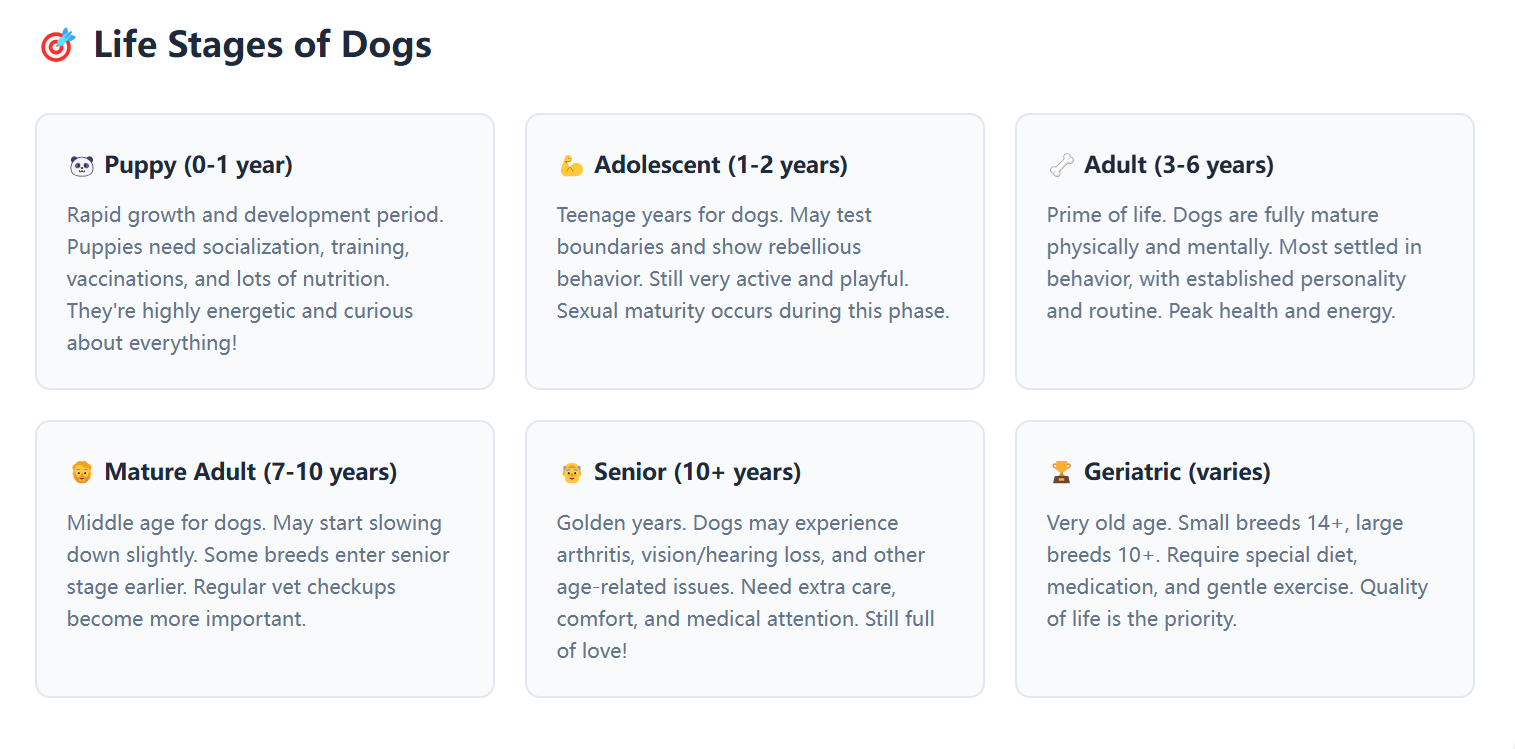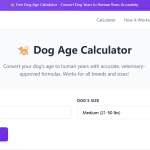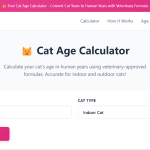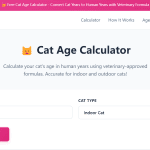As our beloved canine companions enter their golden years, their needs evolve significantly. Understanding these changes and adapting your care approach can help ensure your senior dog enjoys a comfortable, healthy, and fulfilling life. This comprehensive guide covers everything you need to know about caring for aging dogs.

Your Dog’s Human Age
When Is a Dog Considered “Senior”?
The transition to senior status varies by breed and size. Generally, dogs are considered senior around:
- Large and giant breeds (over 90 lbs): 5-6 years old
- Medium breeds (20-90 lbs): 7-8 years old
- Small breeds (under 20 lbs): 9-10 years old
Larger dogs age faster than smaller breeds, making early awareness of senior care needs particularly important for owners of big dogs.
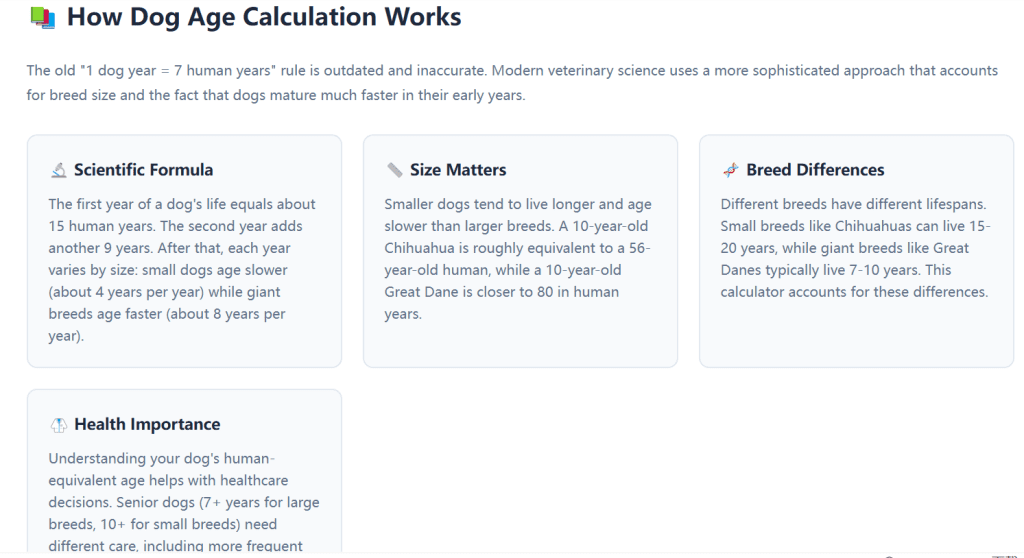
Nutrition for Senior Dogs
Adjusting Caloric Intake
Senior dogs typically have slower metabolisms and reduced activity levels, requiring 20-30% fewer calories than their younger counterparts. Overfeeding can lead to obesity, which exacerbates joint problems, heart disease, and diabetes.
Key Nutritional Requirements
Protein: Contrary to old myths, senior dogs need high-quality protein to maintain muscle mass. Look for diets with 25-30% protein from lean sources like chicken, fish, or turkey.
Joint Support: Ingredients like glucosamine, chondroitin, and omega-3 fatty acids help maintain joint health and reduce inflammation.
Digestibility: Senior dogs may have more sensitive digestive systems. Choose easily digestible foods with moderate fiber content (3-5%) to support gut health.
Antioxidants: Vitamins E and C, along with selenium, help combat cognitive decline and support immune function.
Feeding Recommendations
- Divide daily food into 2-3 smaller meals to ease digestion
- Ensure constant access to fresh water, as seniors are prone to dehydration
- Consider wet food if your dog has dental issues
- Warm food slightly to enhance aroma and appetite
- Consult your veterinarian about senior-specific formulas
Exercise and Physical Activity
Maintaining Appropriate Activity Levels
While senior dogs need less intense exercise, regular physical activity remains crucial for maintaining muscle tone, joint flexibility, and mental stimulation.
Daily Exercise Guidelines:
- Multiple short walks (10-20 minutes) rather than one long trek
- Low-impact activities like swimming or gentle hiking
- Avoid jumping, rough play, or activities that strain joints
- Monitor for signs of fatigue: excessive panting, lagging behind, or reluctance to continue
Adapting Activities
Replace high-energy games with:
- Gentle fetch on soft surfaces
- Sniff walks allowing plenty of time to explore
- Indoor games like hide-and-seek with treats
- Mental stimulation through puzzle toys
- Short training sessions for cognitive engagement
Health Monitoring and Veterinary Care
Increased Veterinary Visits
Senior dogs should see their veterinarian at least twice yearly for comprehensive check-ups. These visits should include:
- Complete physical examination
- Blood work (complete blood count and chemistry panel)
- Urinalysis
- Blood pressure monitoring
- Weight assessment
- Dental evaluation
Common Age-Related Conditions
Arthritis and Joint Disease: Watch for stiffness, difficulty standing, reluctance to climb stairs, or limping. Treatment may include pain medications, joint supplements, and weight management.
Dental Disease: Senior dogs are prone to periodontal disease, which can affect heart, kidney, and liver health. Regular dental cleanings and home care are essential.
Cognitive Dysfunction: Similar to Alzheimer’s in humans, canine cognitive dysfunction causes disorientation, altered sleep patterns, and behavioral changes. Early intervention with supplements and environmental enrichment can help.
Heart Disease: Monitor for coughing (especially at night), reduced stamina, and rapid breathing. Regular cardiac evaluations are important.
Kidney Disease: Increased thirst and urination may indicate kidney problems. Blood tests can detect issues early.
Cancer: Lumps, unexplained weight loss, persistent sores, or changes in bathroom habits warrant immediate veterinary attention.
Home Health Monitoring
Check your senior dog weekly for:
- New lumps or bumps
- Changes in appetite or water consumption
- Alterations in bathroom habits
- Mobility issues or pain indicators
- Behavioral changes or confusion
- Bad breath or drooling (dental issues)
- Eye cloudiness or vision changes
Quality of Life Improvements
Environmental Modifications
Mobility Assistance:
- Install ramps for furniture, cars, and stairs
- Use non-slip rugs on hardwood or tile floors
- Provide orthopedic beds with memory foam support
- Consider raised food and water bowls to reduce neck strain
- Use harnesses or slings for dogs needing help standing
Comfort Enhancements:
- Maintain comfortable ambient temperatures (seniors are sensitive to extremes)
- Provide multiple comfortable resting spots throughout your home
- Ensure easy access to food, water, and bathroom areas
- Use night lights for dogs with vision impairment
- Block access to stairs if unsafe
Grooming and Hygiene
Senior dogs may need extra grooming assistance:
- Regular brushing to stimulate circulation and check for skin issues
- More frequent nail trims as activity decreases
- Sanitary trims to prevent matting and maintain cleanliness
- Gentle bathing with moisturizing shampoos
- Daily eye and ear cleaning if needed
Mental Stimulation
Keep your senior dog’s mind active:
- Introduce new toys and rotate them regularly
- Practice basic training commands
- Offer food puzzles and snuffle mats
- Provide supervised socialization with gentle dogs
- Maintain consistent routines for security and comfort
Pain Management
Recognizing pain in dogs can be challenging as they instinctively hide discomfort. Watch for:
- Reduced activity or reluctance to move
- Changes in posture or gait
- Decreased appetite
- Excessive licking of specific areas
- Vocalization when touched
- Uncharacteristic aggression or withdrawal
- Restlessness or difficulty finding comfortable positions
Work with your veterinarian to develop a comprehensive pain management plan that may include:
- Non-steroidal anti-inflammatory drugs (NSAIDs)
- Joint supplements
- Physical therapy or rehabilitation
- Acupuncture or laser therapy
- Weight management
- Environmental modifications
End-of-Life Considerations
Assessing Quality of Life
Many veterinarians recommend the “HHHHHMM Scale” (Hurt, Hunger, Hydration, Hygiene, Happiness, Mobility, More Good Days Than Bad) to evaluate your senior dog’s quality of life objectively.
Making Difficult Decisions
When the time comes to consider end-of-life care:
- Consult with your veterinarian about your dog’s prognosis
- Consider in-home euthanasia services for a peaceful transition
- Focus on your dog’s quality of life rather than quantity
- Trust your knowledge of your dog’s personality and happiness
- Seek support from pet loss counselors or support groups
Creating a Senior Care Routine
Develop a consistent daily routine that includes:
Morning:
- Gentle wake-up and bathroom break
- Medication administration with breakfast
- Short walk or light activity
- Grooming check
Midday:
- Bathroom break
- Mental stimulation activity
- Rest period
Evening:
- Second meal with medications
- Moderate exercise
- Quality bonding time
- Final bathroom break before bed
Weekly:
- Thorough health check
- Nail inspection/trimming
- More extensive grooming session
Monthly:
- Weight monitoring
- Assessment of mobility and behavior changes
- Review and update care plan as needed
Caring for a senior dog requires increased attention, patience, and adaptability, but the rewards are immeasurable. By providing proper nutrition, appropriate exercise, diligent health monitoring, and quality-of-life improvements, you can help your aging companion enjoy their golden years with comfort and dignity.
Remember that every dog ages differently. Work closely with your veterinarian to create a personalized care plan that addresses your senior dog’s specific needs. With proper care and love, you can ensure that your faithful friend’s later years are filled with comfort, happiness, and the security of knowing they’re cherished.
The bond you share with your senior dog is a testament to years of loyalty and companionship. Honoring that relationship with exceptional care during their final years is one of the greatest gifts you can give your beloved pet.
